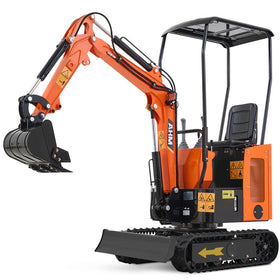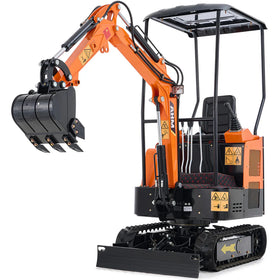You have decided to plant a row of trees on your property because you want more privacy and shade. So you took a shovel and started digging the first hole. Soon enough, you realize that the soil is as hard as rock, and you will need weeks to dig all the holes that you planned to dig.
This is where a skid steer loader with a hydraulic auger attachment can help. In just a few minutes, this machine can dig these holes for you. If you already have a skid steer loader, buying the auger attachment would be a wise thing to do. But how to attach hydraulic auger to skid steer loader? Keep reading to learn more!

1. What Does a Hydraulic Auger Do?
First, let’s learn more about hydraulic auger functions. A hydraulic auger is one of dozens of skid steer loader attachments that you can choose from, depending on your needs. In particular, hydraulic augers are used to drill holes in the ground, especially when there is a need for deep and precise drilling.
Due to the powerful hydraulic system that powers them, these augers can penetrate even the toughest materials, such as frosted soil, hardened clay, and even rocks. Additionally, hydraulic augers come in different diameters and depths, which means you can find the best auger size for any specific job you might have in your mind.
Finally, the hydraulic system gives you better control over the auger, which makes the digging even more precise. This is especially important for projects where you need to dig multiple holes of the exact same depth.

2. Attach Hydraulic Auger To Skid Steer Loader In 6 Steps
Now that you are more familiar with this attachment, it is time to attach hydraulic auger to skid steer loader. It is easier than you might think, just follow the steps below:
1) Prepare The Auger and The Skid Steer Loader
First, park your skid steer loader on a flat surface. This is important because you want your skid steer loader to be stable during the attachment installation. Then, lower the loader arms to the ground, turn on the parking brake, and turn off the engine. You have positioned your skid steer loader just the way you need it.
Now, get your hydraulic auger. Before trying to attach it to the skid steer loader, inspect it carefully. Look if there are any signs of damage, any missing parts, or anything else that could pose a problem later. It’s easier to solve these problems now than later when you have already attached the auger.
2) Position the Auger and The Skid Steer Loader
It is time to align your skid steer loader and the auger so that you can connect them. Slowly drive the steer loader towards the auger. The attachment plate of the loader should be in line with the mounting plate of the auger. If possible, drive your loader close enough so that it connects to the auger. If not, turn off your loader, get out of it, and do it manually.
3) Make Sure The Attachment Plate is Secure
This step is important for preventing the auger from falling off, plus it ensures everything is ready to connect the hydraulic hoses. Get back into the loader, and slightly raise and tilt forward its loader arm. Then, lower the loader arm and tilt it backward. To ensure everything is secure, check if the pins on the attachment plate are perfectly locked into place with the auger. If not, repeat the process until they finally lock in place.
4) Connect The Hydraulic Hoses
Next, find the hydraulic hoses on both the auger and the skid steer loader. Inspect their couplers and make sure to clean them from any debris and dirt. Connect the male and female skid steer loader couplers to the auger. Make sure everything is connected tightly and firmly to prevent the hydraulic fluid from leaking.
5) Test The Attachment
Now that you have connected the hydraulic hoses turn on the skid steer loader and try operating the auger. Move it up and down and rotate it to see if the hydraulic connections are still holding well and if everything else is working as it should.
6) Final Safety Check
Inspect the whole skid steer loader and the auger for signs of any potential issues. Pay close attention if there are any leaks or signs of damage. Use Ziploc ties or hose clamps to keep the hydraulic hoses separated and prevent them from getting tangled.
3. Alternatives to Hydraulic Auger
If you don’t have a hydraulic auger and you still need to do some deep digging with your skid steer loader, there are some alternatives you can try instead. These attachments can also be used with your skid steer loader, and even if they don’t do the exact same job as a hydraulic auger, they are still good enough.
For example, you can use a PTO (power take-off) earth drill. These drills offer less precision than the hydraulic augers, but they can still do a decent job. You can also try a backhoe attachment, but keep in mind that this attachment digs wider holes than a hydraulic auger would. There are also rock wheels with embedded teeth, and they can dig narrow and deep holes.
No matter which type of attachment you choose for digging holes, it is important that you have a powerful and reliable skid steer loader. This ensures that no matter which attachment you use and which work you do, everything will work as intended. If you still haven’t found a perfect skid steer loader for you, check out this high-quality skid steer loader.

Conclusion
A hydraulic auger can be a powerful addition to your skid steer loader. It is a perfect attachment for when you want to dig deep and precisely. This article has shown you how to attach hydraulic auger to skid steer loader, so what are you waiting for? Follow our guide, and you will be digging holes with your hydraulic auger in no time!







